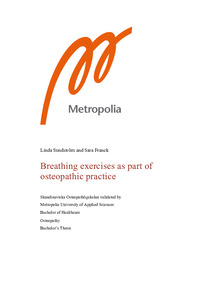Breathing exercises as part of osteopathic practice
Franck, Sara; Sundström, Linda (2022)
Franck, Sara
Sundström, Linda
2022
All rights reserved. This publication is copyrighted. You may download, display and print it for Your own personal use. Commercial use is prohibited.
Julkaisun pysyvä osoite on
https://urn.fi/URN:NBN:fi:amk-2023051210343
https://urn.fi/URN:NBN:fi:amk-2023051210343
Tiivistelmä
Purpose: This study aims to investigate which breathing exercises should be integrated into osteopathic practice and how they are effective.
Method: This literature review includes four randomized controlled trials (RCT) and two clinical trials. Databases used were PubMed and ScienceDirect. Critical Appraisal Skills Programme (CASP) is a checklist that was used to verify the quality of the studies.
Results: The majority of the articles in this literature review indicate that breathing exercises are pain relieving but the mechanisms are unclear. Among the results, there was a decrease in pain and stress, an increase in breathing function and improvement of symptoms of dysfunctional breathing (DB) and quality of life. There were also articles with no significant results. The authors of these articles discussed that these results could have been due to short intervention time, no regular practice and low level of experience regarding the intervention among the participants.
Conclusion: The results of this study give an indication for osteopaths which breathing exercises are the most effective and for what purpose. Thus, more studies are warranted.
Method: This literature review includes four randomized controlled trials (RCT) and two clinical trials. Databases used were PubMed and ScienceDirect. Critical Appraisal Skills Programme (CASP) is a checklist that was used to verify the quality of the studies.
Results: The majority of the articles in this literature review indicate that breathing exercises are pain relieving but the mechanisms are unclear. Among the results, there was a decrease in pain and stress, an increase in breathing function and improvement of symptoms of dysfunctional breathing (DB) and quality of life. There were also articles with no significant results. The authors of these articles discussed that these results could have been due to short intervention time, no regular practice and low level of experience regarding the intervention among the participants.
Conclusion: The results of this study give an indication for osteopaths which breathing exercises are the most effective and for what purpose. Thus, more studies are warranted.
